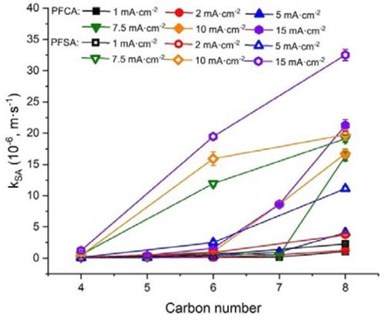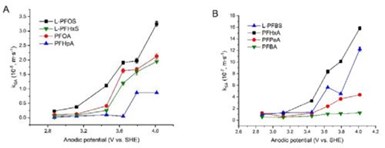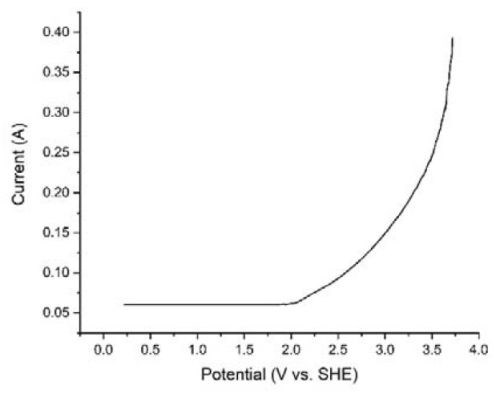NASF/AESF Foundation Research Project #122: Electrochemical Approaches to Treatment of PFAS in Plating Wastewater - 6th Quarterly Report
The NASF-AESF Foundation Research Board has selected a project on addressing the problem of PFAS and related chemicals in plating wastewater streams, studying PFAS destruction via electrooxidation and electrocoagulation. This sixth quarter report covers the continued assessment of eight perfluoroalkyl acids PFAAs most commonly found in wastewaters, by electro-oxidation with a Magnéli phase Ti4O7 anode across a range of anodic potentials in solutions, exploring the reaction mechanisms. To summarize, the PFAAs start to exhibit degradation behavior when the anodic potential reaches a level where water oxidation occurs, suggesting that the hydroxyl free radicals generated via water oxidation play a role in PFAA degradation.
by
Qingguo (Jack) Huang* and Yuqing Ji
College of Agricultural and Environmental Science
University of Georgia
Griffin, GA, USA
Editor’s Note: For 2021, NASF-AESF Foundation Research Board has selected a project on addressing the problem of PFAS and related chemicals in plating wastewater streams. This report covers the sixth quarter of work (April-June 2022). A printable PDF version of this report is available by clicking HERE.
Introduction
This project started in January 2021 with the goal of developing applicable electrochemical approaches to remove per- and polyfluoroalkyl substances (PFASs) present in plating wastewaters, including electrooxidation (EO) and electrocoagulation (EC). This project includes three research tasks that are designed to investigate EC, EO and EC-EO treatment train, respectively, designed to probe three hypotheses specified follows:
1) EC generates amorphous metal hydroxide flocs that can effectively adsorb PFASs in plating wastewater, which, through an appropriate treatment, can release PFASs into a concentrated solution.
2) EO enabled by a Magnéli phase Ti4O7 anode can be used to effectively destruct PFASs in plating wastewater.
3) The electrochemical treatment train comprised of EC and EO by Ti4O7 anode can remove and degrade PFASs in plating wastewater more efficiently than either process operated individually.
This report describes our continuing effort on exploring EO enabled by a Magnéli phase Ti4O7, with a focus on the perfluoroalkyl acids (PFAAs). Eight PFAAs, including perfluorobutanoic acid (PFBA), perfluopentanoic acid (PFPeA), perfluorohexanoic acid (PFHxA), perfluoroheptanoic acid (PFHpA), perfluorooctanoic acid (PFOA), perfluorobutanesulfonic acid (PFBS), perfluorohexanesulfonic acid (PFHxS) and perfluorooctanesulfonic acid (PFOS), were investigated. Their degradation by EO with Ti4O7 anode was examined and compared across a range of anodic potentials, with reaction mechanisms explored.
Experimental
The procedure of the electrochemical oxidation experiments was described in our last report (5th quarterly report). The electrolytic cell (10 cm × 5 cm × 2.5 cm) contained 200 mL target solution, with one Ti4O7 plate (10 cm × 5 cm) placed in the middle as anode and two stainless steel plates of the same size on either side in parallel with a gap 2.5 cm as cathodes. A DC power supply unit (303 DM supplied by Electro Industries Inc) was used to supply electricity at constant current, and the solution was stirred by a magnetic stirrer at a constant speed throughout each experiment. The anodic potential was monitored using a CHI 660E electrochemical workstation (CH Instruments, Inc., Austin, TX) with Ag/AgCl reference electrode placed 0.5 cm from the anode, and all potentials are reported against standard hydrogen electrode (SHE) with internal resistance compensation. The reaction solution was prepared with each PFAA at the initial concentration of 2.0 µM, with 100 mM Na2SO4 as supporting electrolytes, unless otherwise specified. The electric current was applied after 30 minutes of solution stirring in the reactor. Aliquots of samples, 400 μL each, were collected at prescribed time intervals, and the samples were taken after pausing the current for 90 seconds while maintaining stirring to ensure solution homogeneity. Each sample was diluted 1:1 with 0.10 μM M8PFOA and M8PFOS in MeOH and filtered through a nylon-based syringe filter. Samples were processed through a UPLC-MS/MS system (Waters I-class UPLC; Water Xevo TQD triple quadrupole mass spectrometer) in negative electrospray ionization mode using multiple reaction monitoring (MRM). The UPLC was operated with methanol (A) and water (B) (5 mM ammonium acetate in each) as the mobile phases at a flow rate of 0.3 mL/min using a gradient program.
Results and Discussion

Figure 1 - The kSA values of PFAAs of different carbon chain lengths and head functional groups, obtained in electrooxidation experiment with TSO anodes at different current densities. The test solutions contained all PFAAs with each at the initial solution of was 2.0 μM in 100-mM Na2SO4 as supporting electrolyte. Error bar represents standard deviation.
The degradation of PFAA was evaluated with all PFAAs spiked under different current densities, and the surface area normalized reaction rate constants kSA values are plotted in Fig. 1 in relation to the chain lengths and the head functional groups. For each PFAA, the kSA increased with increasing current density. For the PFAAs having the same functional group (PFSAs vs. PFCAs), the increase in carbon chain length led to greater reactivity. This is in accord with other studies showing shorter chain PFAAs more recalcitrant to electrooxidation.1,2 For the PFAAs of the same carbon chain length, the ones with sulfonate head group tend to degrade faster than those with carboxylic group.
Increased PFAA removal under higher current densities may be ascribed to the higher anodic potentials. The surface area normalized degradation rate constant for each PFAA obtained from the experiments are plotted against anodic potential in Fig. 2.

Figure 2 - The kSA values of 8 PFAAs plotted against the anodic potential vs. SHE (standard hydrogen electrode) for electrooxidation. The test solutions contained all PFAAs with each at the initial solution of was 2.0 μM in 100-mM Na2SO4 as supporting electrolyte. The error bar represents the standard deviation. The data are shown in two figures according to magnitudes for better observation.
It is again evident that the PFAAs with relatively longer carbon chains tend to have greater degradation rates across the tested anodic potential range than the shorter ones, as well as the PFSAs have higher rates than the PFCAs (Fig. 2). Regardless of the length of carbon chains, all PFAA degradation rates increased along with the anodic potential. The PFAAs started to exhibit degradation behavior when the anodic potential was above about 2.83 VSHE (standard hydrogen electrode). This corresponds to the anodic potential where water oxidation started to occur according to linear sweep voltammetry (LSV) shown in Fig. 3, which corroborates that the hydroxyl free radicals generated via water oxidation play an essential role in PFAA degradation during electrooxidation on TSO anode.2 It is noted that direct electron transfer (DET) and hydroxyl radical attack take place in a concerted manner that leads to PFAA degradation during electrochemical oxidation.3

Figure 3 - Profiles of linear sweep voltammetry (LSV) at a scan rate of 50 mV/sec in 100-mM Na2SO4 solution with TSO anode.
To summarize, the PFAAs started to exhibit degradation behavior when the anodic potential was above about 2.83 VSHE when water oxidation occurs, suggesting that the hydroxyl free radicals generated via water oxidation play a role in PFAA degradation. For the PFAAs having the same head acid group (PFSAs vs. PFCAs), the increase in carbon chain length led to greater reactivity. For the PFAAs of the same carbon chain length, the ones with sulfonate head group tend to degrade faster than those with carboxylic group.
References
- C.E. Schaefer, C. Andaya, A. Urtiaga, E.R. McKenzie and C. P. Higgins, “Electrochemical treatment of perfluorooctanoic acid (PFOA) and perfluorooctane sulfonic acid (PFOS) in groundwater impacted by aqueous film forming foams (AFFFs),” Journal of Hazardous Materials, 295, 170-175 (2015).
- H. Lin, J.F. Niu, S.T. Liang, C. Wang, Y.J. Wang, F.Y. Jin, Q. Luo and Q. G. Huang, “Development of microporous Magneli phase Ti4O7 ceramic materials: As an efficient anode for mineralization of poly- and perfluoroalkyl substances,” Chemical Engineering Journal, 354, 1058-1067 (2018).
- H. Shi, Y. Wang, C. Li, R. Pierce, S. Gao and Q. Huang, “Degradation of Perfluorooctanesulfonate by Reactive Electrochemical Membrane Composed of Magnéli Phase Titanium Suboxide,” Environmental Science & Technology, 53 (24), 14528-14537 (2019).
Past project reports
1. Introduction to Project R-122: Summary: NASF Report in Products Finishing; NASF Surface Technology White Papers, 85 (6), 13 (March 2021); Full paper: http://short.pfonline.com/NASF21Mar1.
2. Quarter 1 (January-March 2021): Summary: NASF Report in Products Finishing; NASF Surface Technology White Papers, 85 (12), 13 (September 2021); Full paper: http://short.pfonline.com/NASF21Sep1.
3. Quarter 2 (April-June 2021): Summary: NASF Report in Products Finishing; NASF Surface Technology White Papers, 86 (3), 18 (December 2021); Full paper: http://short.pfonline.com/NASF21Dec2.
4. Quarter 3 (July-September 2021): Summary: NASF Report in Products Finishing; NASF Surface Technology White Papers, 86 (6), 16 (March 2022); Full paper: http://short.pfonline.com/NASF22Mar2.
5. Quarter 4 (October-December 2021): Summary: NASF Report in Products Finishing; NASF Surface Technology White Papers, 86 (9), 21 (June 2022); Full paper: http://short.pfonline.com/NASF22Jun2.
6. Quarter 5 (January-March 2022): Summary: NASF Report in Products Finishing; NASF Surface Technology White Papers, 86 (12), 22 (September 2022); Full paper: http://short.pfonline.com/NASF22Sep2.
About the author

Qingguo (Jack) Huang is Professor in the Department of Crop and Soil Sciences, University of Georgia, Griffin Campus. He holds a B.S. in Environmental Science (1990) and a Ph.D. in Chemistry (1995) from Nanjing University, China as well as a Ph.D. in Environmental Engineering from the University of Michigan, Ann Arbor, Michigan. Dr. Huang’s research interest focuses on catalysis involved in the environmental transformation of organic pollutants, and development of catalysis-based technology for pollution control and environmental remediation and management. His laboratory has been actively involved in several cutting-edge research topics:
- Enzyme-based technology for water/wastewater treatment and soil remediation
- Electrochemical and reactive electrochemical membrane processes in wastewater treatment
- Catalysis in biofuel production and agro-ecosystem management
- Environmental fate and destructive treatment methods of PFASs
- Environmental application and implication of nanomaterials
He has published over 160 peer-reviewed journal articles, five book chapters and four patents and three patents pending. He has taught three courses at the University Georgia: Introduction to Water Quality, Environmental Measurement and Advanced Instrumental Analysis in Environmental Studies.
* Principal Investigator (PI) Contact Information:
Qingguo Huang, Ph.D, Professor, Department of Crop and Soil Sciences, University of Georgia
1109 Experiment St.
Griffin, GA 30215, USA.
Phone: (770) 229-3302
Fax: (770) 412-4734
E-mail: qhuang@uga.edu
Related Content
NASF/AESF Foundation Research Project #120: Electrochemical Destruction of Perfluorooctanesulfonate in Electroplating Wastewaters - April 2022-March 2023
This NASF-AESF Foundation research project report covers project work from April 2022 to March 2023 at the University of Illinois at Chicago. The overall objective of this work is to utilize a cost-effective reactive electrochemical membrane (REM) for the removal of PFAS from synthetic electroplating wastewater. Initial results for the oxidation of PFOA with three different catalysts are discussed.
Read MoreUltrafiltration Membranes, Filter Elements for Improved Industrial Water Reuse
Ultrafiltration membranes help with water reuse in a variety of applications.
Read MoreNASF/AESF Foundation Research Project #120: Electrochemical Destruction of Perfluorooctanesulfonate in Electroplating Wastewaters – January – December 2023
This NASF-AESF Foundation research project report covers quarterly reporting for the year 2023 at the University of Illinois at Chicago. The objective of this work is to utilize a cost-effective reactive electrochemical membrane (REM) for the removal of PFAS from synthetic electroplating wastewater. Discussed here are the oxidation of PFOA with three different catalysts, development of a method for detecting PFAS, as well as work on 6:2-fluorotelomersulfonic acid (6:2 FTS) and electrodeposited bismuth/tin oxide catalysts.
Read MoreNASF/AESF Foundation Research Project #122: Electrochemical Approaches to Treatment of PFAS in Plating Wastewater - 9th Quarterly Report
The NASF-AESF Foundation Research Board selected a project addressing the problem of PFAS and related chemicals in plating wastewater streams. This report covers the ninth quarter of work (January-March 2023). In this report, we describe our work on evaluating the performance of PFAS degradation by electrooxidation using surface fluorinated Ti4O7 anodes in batch mode.
Read MoreRead Next
Episode 45: An Interview with Chandler Mancuso, MacDermid Envio Solutions
Chandler Mancuso, technical director with MacDermid Envio discusses updating your wastewater treatment system and implementing materials recycling solutions to increase efficiencies, control costs and reduce environmental impact.
Read MoreA ‘Clean’ Agenda Offers Unique Presentations in Chicago
The 2024 Parts Cleaning Conference, co-located with the International Manufacturing Technology Show, includes presentations by several speakers who are new to the conference and topics that have not been covered in past editions of this event.
Read MoreDelivering Increased Benefits to Greenhouse Films
Baystar's Borstar technology is helping customers deliver better, more reliable production methods to greenhouse agriculture.
Read More










.jpg;maxWidth=300;quality=90)










